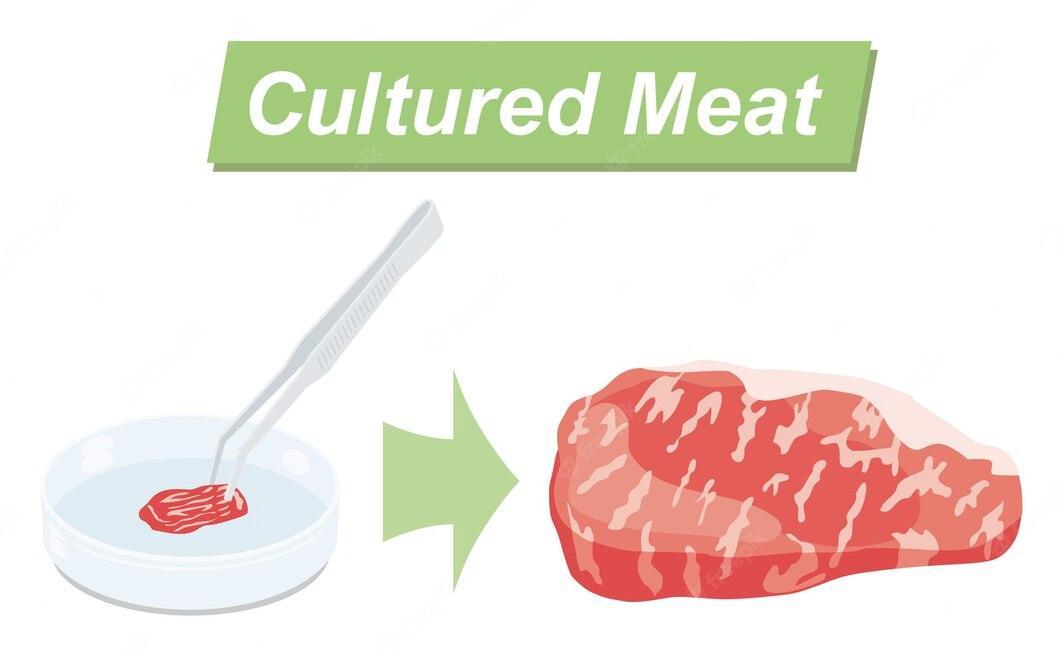We are all aware that the food we consume has an impact on our bodies, but it may also have an impact on our environment. Those of us who eat animal products and byproducts, like fish, eggs, dairy, or meat, are probably aware that where our food comes from, how it’s made, and the circumstances the animals live in may all have a long-term influence on the environment.
While purchasing organic, local, or free-range is a terrific method to guarantee that we are being environmentally friendly with our purchases, it is not the only option we have in the future.
Cell cultured meat, also known as lab-grown, clean, or cultivated meat, is produced in a laboratory from a small number of animal cells. It’s genuine meat, but unlike traditional meat, it doesn’t need the death of animals.
This technique allows for the production and intake of fish and meat without the slaughter of any animals. Cultured meat is also seen as a less harmful option to factory farming, which is a major source of greenhouse gas emissions and nutrient contamination.
The goal is to make the meat business more environmentally friendly and compassionate. Cellular agriculture, according to several industry experts, is the wave of the future. It was being worked on by 55 firms throughout the world at the end of 2019.
However, cultured meat is still in its infancy. It’s yet unclear how healthful and cost-effective cultured meat will be, or whether it will appeal to consumers. It might be months or years before cultured meat is available on supermarket shelves or in restaurants.
How to Make Cultured Meat?
Scientists extract stem cells, also known as building block cells, from an animal to create lab-grown meat. They soak the cells in a nutrient-rich liquid before placing them in a bioreactor, a laboratory apparatus for growing organisms.
Once the “unstructured” flesh has evolved, the next stage is to turn it into a realistic meat product. Companies are attempting to figure out the best technique to make burgers, nuggets, and other goods using cultured meat. Some are shaping the lab-grown flesh using “scaffolding” created from soy protein, gelatin, or other sources.
This process should take 2 to 8 weeks, depending on the type of meat being grown.
What About Food and Nutrition?
Meat consumption has been linked to chronic illness. However, while scientists can manipulate the levels of fat and cholesterol in cultured meat, the evidence is unclear regarding the nutritional impact of lab-grown meat.
Can Vegetarians Consume Lab-Grown Meat?
But First Let’s See What is Cultured Meat?
Unlike plant-based meat products, which are manufactured entirely of plant components, lab-grown meat is an animal product, which is why it is not regarded as a portion of vegan food. Since lab-grown meat will require starting cells continuously, which means biopsies from live animals will always be necessary, and because certain parts of the process necessitate the slaughter of animals, vegetarians and vegans may choose to avoid consuming these products.
For vegetarians who are aware of these difficulties and continue to consume animal products other than meat, lab-grown meat may be enticing, especially because it requires significantly fewer animals to be killed and is unquestionably more ethical. Many people are still hesitant, and some have even proposed creating a new category of people who only consume cell based meat. Perhaps clean carnivores?
The Advantages of Cultured Meat
Some of the Possible Advantages of Lab-grown Beef Include:
- Animals are Treated More Humanely. While cultured meat necessitates a tiny amount of tissue, it does not necessitate the death of an animal. Cells can be extracted from a living animal. Some of the nutrient baths used to develop the cells contain blood from slain animals, but others do not.
- Reduced Environmental Effect. More wooded areas are being transformed into ranches and farming fields as worldwide demand for meat along with meat cutting knives rises. Cultured meat consumes less land, uses less water, and emits fewer pollutants.
Furthermore, typical beef production emits significant amounts of nitrous oxide, carbon dioxide, and methane, all of which contribute to global warming. Lab-grown beef has the ability to reduce these emissions significantly.
- Using Fewer Antibiotics. Antibiotics are frequently administered to traditionally kept animals to help keep them healthy. This can result in antibiotic resistance, in which the medications no longer function as well against infections as they previously did.
- There is Less Pollution. Cultured meat supporters claim it is significantly less likely to be contaminated by E. coli bacteria and other pollutants found in meat processing plants.
Concerns Regarding Lab-Grown Meat
While cultured meat on your meat cutting board has a bright future, there are several issues, such as:
- Will it be purchased? Some individuals find the concept of lab-grown meat unappealing. Journalists gave cultured burgers mixed ratings in a 2013 taste test. However, research is proceeding apace, and public perception is vulnerable to shift when there is an increase in Online Shopping in Kuwait. So, in many respects, the verdict is still out.
- Its cost. In 2012, scientists created the first cultured beef hamburger. It cost $325,000 to build. However, as technology progresses, the cost of synthetic meat should decrease. According to one expert, large-scale production may reduce the price of a 5-ounce burger to roughly $11 — still pricey, but not unreasonably so.
- It isn’t vegan. Because lab-grown meat comprises animal cells, it is not vegan. And many vegetarians are conflicted about how they feel about this type of meal.
Furthermore, many adherents of the Jewish, and Hindu faiths are unsure if cultured meat would be permissible under their dietary requirements.
What are the Possibilities?
The procedures for producing lab-grown meat are still in the early stages of development, but possible benefits include larger yields, decreased consumer costs, improved quality, and a smaller environmental effect. Consider the possibility of nourishing a space station or a Mars colony for space enthusiasts in meat cutting gloves.
Conclusion:
What is cell cultured meat? Lab-grown meat or cell-cultured meat is molecularly equivalent to meat, however, it is NOT the same as plant-based meat alternatives.
Although no animals are sacrificed in the production of cell-based meat, the result is similar to actual meat.




